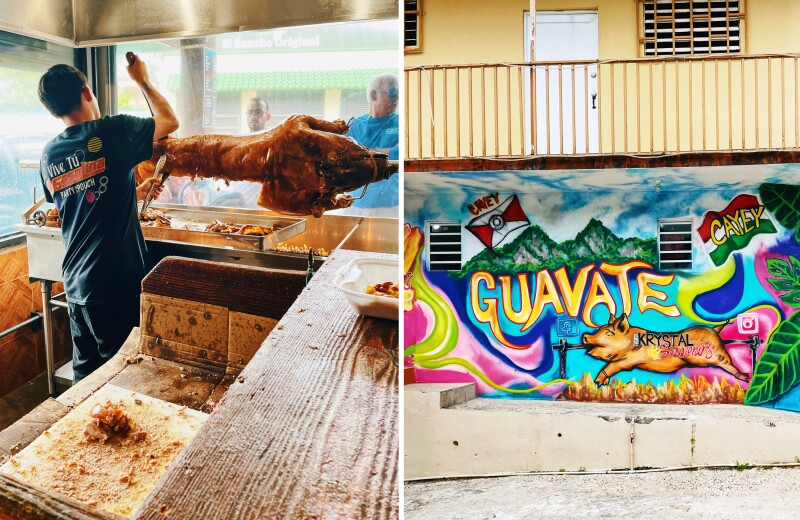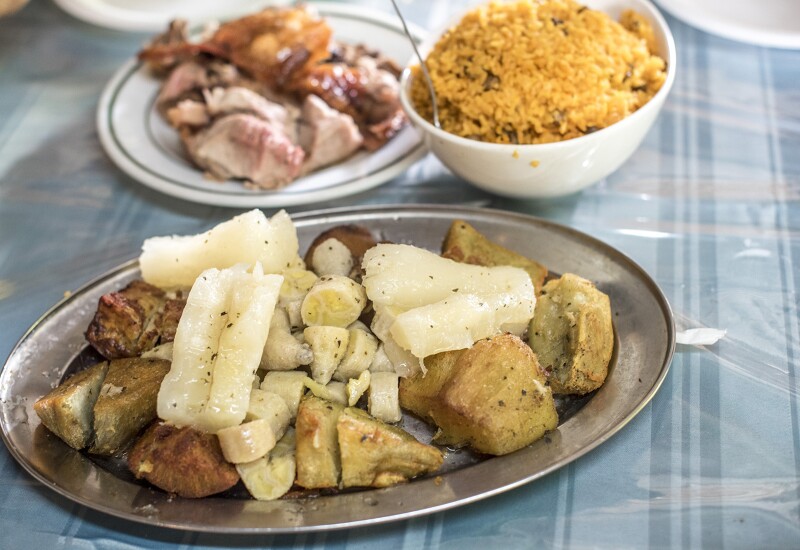This article is part of a series created by United Voices, a new AFAR immersion program that brings together local content creators and AFAR editors for workshops, reporting stories, and experiencing a destination together. We make our debut in Puerto Rico.
Puerto Rico‘s culinary scene has long been influenced by the spectrum of people who have inhabited the island.
“[Puerto Rican cuisine] is a combination of African culture, the Spanish, and the Indians and we still today have the influence very, very present in our food,” says Luis Andres Cabrero, a Puerto Rican chef based in Caguas who has worked with the cuisine for more than a decade.
At the same time, Puerto Rican cuisine is also forged by its tropical environment, from its bounty of seafood to abundance of passionfruit, gigantic avocados, and guava. These influences shape a vibrant cuisine that can be tasted on a plate—here are 10 classic Puerto Rican dishes that you shouldn’t miss.
1. Arroz con gandules
Arroz con gandules is a staple dish found in most places where Puerto Rican cuisine is served. As the name implies, the main parts of the dish consist of yellow rice and a type of tropical pea called the pigeon pea (it’s similar in look and taste to the green pea). Seasoned with sofrito—which combines green peppers, onion, garlic, sweet peppers, and culantro—the dish is a mild base that’s often paired with meat, allowing the main to shine.
Arroz con gandules can be modified with extra proteins like sausage and vegetables—although according to Cabrero, most restaurants in Puerto Rico serve arroz con gandules as a solely peas-and-rice operation.
Where to try it
Try pairing an order of arroz con gandules with lechón asado, another Puerto Rican staple, at a lechonera like Lechonera Los Amigos.
2. Limber

One way to eat limber? Flip the iced concoction upside down.
Photo by Jesse Echevarria
The tropical, humid climate of Puerto Rico often calls for an icy treat called limber. The origin of its name is attributed to U.S. pilot Charles A. Lindbergh, who landed on the main island in the 1920s. Puerto Ricans offered the aviator this frozen juice dessert, which became known as “limber” thanks to local pronunciation of the pilot’s last name.
Limber is a mix of ice, fruit (or another flavor), sugar, and some type of milky ingredient (like evaporated milk or condensed milk) in a plastic cup.
Where to try it
Street vendors sell flavored limbers like coconut, guava, and strawberry for around $1.50 for those seeking a way to cool off.
3. Frituras
A delicious companion to a day at the beach are frituras. These fried snacks are found throughout the island, especially at the beach. There are several varieties of frituras. Whether bacalaítos (crispy codfish fritters), alcapurrias, (fried masa of green bananas), or yuca filled with meat, there’s something for every taste. At many fritura stands, you can also find empanadas with various fillings. Seafood lovers will appreciate empanadas filled with local jueyes (crabmeat).
Where to try it
Frituras are available at most beach areas in Puerto Rico. Some notable spots are Piñones located in Loíza outside San Juan, the Kiosks in Luquillo Beach, and La Guancha, a boardwalk in the southern town of Ponce.
4. Tostones

In some parts of Latin America, tostones are known as patacones.
Photo by Michelle Heimerman
Tostones are salty fried plantains that are practically ubiquitous in Puerto Rican restaurants. To create this side dish, chefs take an unripened plantain and fry it, smash it into a round medallion, and then fry it again. These golden disks are usually dipped in a garlic herb or mayo-ketchup sauce, complementing the slightly dry texture that comes from all of that time being fried.
Where to try it
Head to any Puerto Rican restaurant and tostones will probably be offered as a side, ideal for snacking or to complement an entrée.
5. Mofongo
This hearty dish is a hallmark entrée of Puerto Rican cuisine and consists of an unripened green plantain that’s topped or stuffed with meat or seafood (depending on preference). Mofongo is created by softening the plantain by frying or boiling it, and then mashing it together with garlic and pork cracklings. A garlic- or tomato-based sauce typically tops the entire dish.
Where to try it
Mofongo isn’t too hard to find, especially in popular restaurants like Café Manolín and Bebo’s Café in San Juan.

The central barrio of Guavate is known for its abundance of lechoneras.
6. Lechón asado
Lechón asado, also known as roasted suckling pig, features a whole pig that’s been slow cooked for hours, rotisserie style. While similar iterations of this dish exist around the world, from Spain to the Philippines, Puerto Rico’s lechón is usually seasoned with garlic, oregano, achiote oil (oil made from annatto seeds), salt, and pepper. This mild seasoning lets the pig’s natural flavor come in full, meaty force. While the inside portions are certainly filling, a good crunchy skin is the gold standard of a well-cooked lechón.
Where to try it
Lechón asado is available in dedicated restaurants known as lechoneras around Puerto Rico, particularly along a road in Guavate known as la ruta de lechón, or “the Pork Highway.”
7. Pastel
The pastel is a snack-size dish that’s usually eaten during special occasions or holidays (though some restaurants sell these savory rectangles). It may look like the Mexican tamale, but there are a few key differences: The masa (flour) of a pastel is made of plantains and root vegetables like yuca, which is then wrapped in a banana leaf, while the masa of a tamale is usually made of corn and wrapped in a corn husk. Pasteles are also boiled, while tamales are steamed. Pasteles can be mixed with an endless combination of vegetables and meats, packing a mouthful of umami flavor in every forkful.

Morcilla can usuallly be identified from other sausages with its dark color.
Photo by Michelle Heimerman
8. Morcilla
With European roots dating back more than 500 years, morcilla is common in Puerto Rican cuisine. This is essentially blood sausage: ground pork and pork blood mixed with rice, cilantro, garlic, and chili pepper. The idea of this dark-colored meat can be intimidating for some—for those squeamish around the idea, other types of sausages like chorizo and longaniza are common in Puerto Rico, too.
Where to try it
Exquisite morcillas can be found at Casa Vieja, a cozy restaurant in Ciales, served as an appetizer. Get a plate with a passion fruit sangria and take in the views of the mountains.

A mallorca, a fluffy roll topped with powdered sugar, is a must try in Puerto Rico.
Photo by Jessica van Dop DeJesus
9. Mallorca
Puerto Rican food offers a lot of savory, but a trip to the local café or bakery known as a panadería reveals that there’s plenty to satisfy a sweet tooth. The mallorca is one such pastry, with a spiral center bearing resemblance to the Spanish ensaimada. (The term mallorca actually comes from the namesake island in Spain, where ensaimada originated.) This fluffy roll is served at breakfast, and its sweetness pairs well with coffee. The bread itself can be eaten alone or cut and repurposed as the top and bottom layers of a sandwich.
Where to try it
A classic spot for mallorcas is Cafetería Mallorca, the historic bakery in Old San Juan. If you’re traveling along the west coast of the island, check out Ricomini, a local bakery chain known for its sandwiches.

Viandas includes a variety of root vegetables including yuca or yams.
Photo by Jessica van Dop DeJesus
10. Viandas
Some people say that Puerto Rico is not a vegetarian-friendly destination, but we beg to differ. More people are adopting vegetarian and vegan diets, and many of the base recipes feature viandas. A vianda platter usually includes root vegetables such as yuca (cassava), malanga (taro), yautia (a version of taro), ñame root, and yams. You may also find green bananas and pumpkin in the mix. These vegetables are rich, versatile, and very filling. Viandas are a common side dish with lechón asado, but they can carry plenty of weight on their own.
Where to try it
Viandas are associated with el campo, the countryside. From the classic boiled root vegetables with olive oil and vinegar to more creative dishes, you can find viandas all over the island. Bacoa, an inventive restaurant in the mountains of the town Juncos, uses viandas uniquely on its menu. There, you can find a fire-roasted pumpkin or creative dips with root vegetables.
This article was originally published in March 2021 and was updated in May 2023, with additional reporting from Chloe Arrojado.











